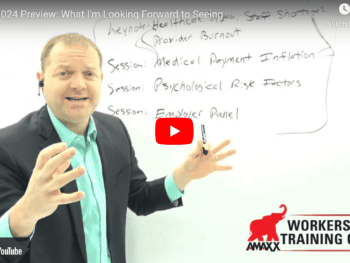WC National Conversation Series:
- Part #1 WC National Conversation: Political Influence, History, And Current Major WC Issues
- Part #2: WC National Conversation: Imperative Issues and Friction Points
- Part #3: WC National Conversation: Regulations, Unintended Consequences, & Standards
Hello Michael Stack here, principle of Amaxx, founder of COMPClub, and co-author of Your Ultimate Guide to Mastering Workers’ Comp Costs. This is my third part in a 3-part series, really highlighting and summarizing the national workers’ compensation conversation. This is a conversation in our industry, and an important one to talk about the current status, and really future of our industry. On May 10th and 11th, 2016, 39 individual stakeholders came together representing various interests and various perspectives at the workers’ compensation summit held in Dallas. The event was hosted by Bob Wilson from workerscompensation.com, and Deputy Chief Judge, David Langham..
Questions About Fairness & Adequacy of Current System
There have been questions about the fairness and adequacy of the current workers’ compensation system, and if that’s the right system to handle workplace injuries today and moving into the future. In the first video, I talked about the pre-summit documents, and went over a lot of the history, and current major issues. If you haven’t looked at that video yet, I highly recommend checking it out. There is a lot of information in there, and I guarantee you’re going to learn something. In the second video, I went over really the bulk of our discussions in Dallas, identifying those imperative issues, and friction points in the industry, that are currently causing a lot of the challenges. In this final video then, I want to talk quickly about some of the specific regulatory points that we identified. Some of the different incentives, and then where are we going to go from here.
My three major topics today then, are really communication or lack there of between the regulators and the insurance marketplace. The second about the unintended consequences that come from regulations. Then finally about equity or the fairness of the current work comp system. Then consistency among the states and where we’re going from here.
Lack of Communication Between State Regulators & Insurance Market
Let’s talk first about communication. Communication is imperative in every single aspect of what we do in workers’ compensation management. That is certainly the case when you’re talking about the communication or lack thereof, between the state regulators and the insurance marketplace. I mentioned in the first video the 1972 commission, and the report that they gave. They mentioned this point specifically in that report. They talk about really the lack of understanding among the regulators. Then even once the regulators do understand and have interests in the workers’ compensation industry, now trying to put reforms in place that aren’t going to have these unintended consequences.
Regulator Perspective
Let’s talk quickly about the regulator perspective. In the Dallas summit there were regulators who were in attendance, who were able to gain this perspective. What a regulation does or what the work comp laws do in each state, they provide information and structure regarding the audit. They provide protection, and they provide accountability among the various stake holders to follow these particular laws. A lot of value comes from that structure, without structure then you have chaos and with chaos becomes poor outcomes. It does provide a lot of structure as far as making sure the audits are done properly, making sure the different stake holders are protected, and having that accountability. Too much regulation though can lead to unintended consequences that we’ll talk about in a second.
Is Vagueness a Benefit or Detriment?
A couple different things in regard to regulations that were discussed, was vagueness. Is vagueness a benefit or a detriment. Using words like reasonable, leaves things open to interpretation, leaves things open to litigation. Parallel this with the American with Disabilities law, which I think is very similar in a lot of ways in the outcomes in regards to these employees. In that law, there’s words like reasonable accommodations, words like interactive process, words like undue hardship. Extraordinarily vague terms with leaves things open to a lot of interpretation. Is a word like reasonable in the work comp laws the thing that we want. Is that causing the right outcome? Do we want that to be more specific in the light of the outcome that we’re trying to accomplish? That’s the question there really in regards to what that looks like from a state regulation perspective.
Who Benefits From Regulations?
Finally and I think an important point here, when you’re talking about the value and the communication between regulators and the insurance marketplace, who’s benefiting from these? At the center of the grand bargain is the employee and the employer. The employee and employer at the center of the grand bargain discussion. When you start to get into some of these regulations, why are they in place? Who’s benefiting it? Is it the state that’s benefiting? It’s just making their system easier because this is the way we do it in our office. We need everyone to follow our individual system. We’re not willing to change because of it. Is that benefiting the employee because of that? It’s debatable. Is it benefiting the employer? It’s certainly debatable. The two parties that are at the center of this work comp grand bargain discussion, who is benefiting from these regulations? Having that part of discussion, and is it a part of the discussion at the regulation level? Sometimes yes, a lot of times though, no.
Unintended Consequences
Sunset Regulations
That brings us then to the next point, which is unintended consequences. When a regulator will write these laws and pass them, it’s for good intentions. They will generally have good intentions because they’re trying to put this protection, this accountability to have things run smoothly in their states, for their employees, for their employers, and for the various stakeholders involved in the work comp system. Let’s talk about some of the unintended consequences that occur. A lot of the stories when you hear about the reforms, of the reforms, of the reforms, are because of this very point. The first point that was discussed is how do you then get rid of regulations. Maybe a regulation was created because it needed to be. An issue was coming up and there was a lack of accountability or there was a lack of protection for a certain group. You needed to pass a regulation to do that.
That regulation is now irrelevant. Now it continues year, after year, after year, after year. It’s not benefiting the states really. It’s not benefiting the employees. It’s benefiting the employers. It’s an irrelevant regulation. It’s causing additional reforms, additional burden, additional costs on the work comp industry. Where’s the benefit? How do you get rid of these regulations that are irrelevant? What if the states talked about a task force that’s actively reviewing their regulations? Actively reviewing their forms and getting rid of the ones that are unnecessary, getting rid of the ones that are not causing any benefit, that are just driving up costs.
Cost Burden
Which leads me then to the next point and this is a big one. Any regulation, even a small change can put a tremendous burden of cost on the insurance marketplace. Let’s talk about an example here. Data is certainly becoming more popular, particularly analytics are becoming more popular. The world in general has a hunger for data. That is certainly true and certainly relevant in our industry, even at the state level. Let’s say the states ask the carriers, TPAs, self-insureds, everyone submitting data to the state, they just ask them for one more data element. They want us to provide us with one more data element. The cost and burden that puts on the industry is millions and millions of dollars. Now every one of the vendors, every one of the employers, every one of the carriers, TPAs, has to reprogram their system now to add this one data element. What benefit is that giving to the employers? What benefit is that giving to the employees? The injured workers, the employers, at the heart of this grand bargain conversation. That’s the question and the unintended consequence, enormous cost burden put on the industry.
Incentives
Which brings us then to the next point, when you talk about these incentives. I talked about these before in the last video. I want to hit on it here. Often will be an unintended consequence of a state regulation that causes some of these problems and causes human behavior then to adjust. Let’s give an example of this. The claim costs as they go down … I’m sorry, as the claim outcome goes down it gets worse. The claim costs go up. I want to use an example here of a medical fee schedule. We’ve seen this passed in many states. A state will pass a fee schedule to drive down those costs and try to keep a hold of this. Where is the incentive then from a human nature standpoint?
We talked about some of those medical providers. Maybe some of the bad actors that now say, “Well I don’t really care about the outcome. All I want to do is increase my revenue.” My incentive then is to increase the amount of treatments. If I’m getting less for a certain treatment, I’m going to maybe do a different treatment, or I’m going to do more treatments, so that my revenue can remain the same. The lawyer will have the incentive to drive up the costs of the claim so that their fee can be higher. Some of these incentive points that are unintended consequences of certain regulations.
What Incentive Exists For Employers, The Most Important Party
The last point then here and a big one in regards to incentives, the party that has the most control, the most incentive to do right, the most incentive to get their employees back to work, the most incentive to report those claims timely, work with medical providers for these positive outcomes, is the employers. The employers are also the least educated and least involved in general. There are certainly the A students that are doing tremendous work in regards to work comp management. Putting systems in place, putting some resources in place, to actively involve their employers, their company in this process of working with their employees to get back to work. They see these dramatically positive results. It’s not a question of how to do it. That system has been defined and proven over years, and years, and years, and hundreds and thousands of employers that follow that system.
The question then is how do you incentivize those employers to care? The small to medium size employers, or even the large employers, that are feeling it in the pocketbook, or maybe they’re not feeling it in the pocketbook. They only have a couple of claims per year but now they don’t know how to handle it. That five percent of claims that causes eighty percent of the lost time in cost, which we talked about in prior videos, that’s where that comes. It comes from these ill prepared employers, these employers that are not involved. How do you then incentivize the most important party in this discussion to get involved in the discussion and in the management of their injuries? A hugely important point there in regards to the employers.
Consistency Among States
Which brings me then to my last point, which is really this idea of consistency among the states, and where we want to see this thing go from here. You talk about really back to that 1972 reform which I mentioned early at the beginning of this video series. It was mentioned at the beginning of that work comp summit. It was a major study that was done. They recommended nineteen different minimum standards for what the states should follow. It was really never implemented from a national or a federal level, that the states had to meet those regulations. The states met the call throughout the 1980s and early 1990s. Then as since has continued to deteriorate from there. The question is, is that where we are today? Are we in need of that uniformity? Are we in need of those recommendations or those minimum standards? It’s a question of figuring out where we want to go then as an industry.
Huge Variations In State Benefits
There are huge variations among the states. There’s huge differences among the different states. It becomes very traumatic when you’re reading like a pro public report. You see the costs of an arm in one state is X, and in another state it’s Y. It doesn’t seem to make a lot of sense, and lends our industry to criticism. It makes the outsider look in and say, “Well that doesn’t seem fair.” It makes me question the entire system. It makes me question the entire industry, when we know that the vast majority of claims go through the system, and it’s a hugely beneficial protection for injured workers, and also for employers. Really saving them, allowing them to budget, really reducing their amount of liability for some wide swings and negligence claims, that could put them out of business.
Are We Looking For More Uniformity?
Those huge variations lends our industry to criticism. Is that where we are today? Are we looking for uniformity? Is the fact that we have fifty states and fifty different interpretations of the law, actually one of our greatest benefits? That’s up for you to decide. That’s up for our industry to decide, to have this discussion as far as where we want to see this go from here. I’ve gone through what that discussion was in Dallas. This is where we left it. There was a lot of hesitation in really talking about exactly what the goal is of this conversation. I’m going to leave that for you to ponder. How that would impact you. Talk about what is this ideal outcome? What are we trying to look for? A positive person for one person can be a very negative outcome for another. There’s so many stakeholders involved. How do we now come together as an industry, and decide where we want to go from here?
Join The Conversation
A couple of upcoming opportunities for you to give involved in this discussion, which I’ll be reporting on in the recent weeks and months to come. There’s a town hall webinar that I’ll be hosting. You are invited to participate. It’s going to be Thursday, June 9th at one o’clock pm eastern standard time. It’ll be a 50-minute live webinar that I’ll be moderating and asking for your input on this material. Some different things that maybe we didn’t cover or I didn’t cover throughout the course of this video series, and different perspectives that you want to share. Also talking about your goals and where you want to see this go from here. The next time we’ll be getting together as a group will be in August. From that group that originally met in June and I’ll be reporting on that summit discussion as well.
I want to thank you for your participation in this series. I want to thank you for your interests in following along with this material. This industry can’t get to where it needs to get to without your input and without your perspective. Remember, your success in workers’ compensation is defined by your integrity, so be great!
Author Michael Stack, Principal, COMPClub, Amaxx LLC. He is an expert in workers compensation cost containment systems and helps employers reduce their work comp costs by 20% to 50%. He works as a consultant to large and mid-market clients, is co-author of Your Ultimate Guide To Mastering Workers Comp Costs, a comprehensive step-by-step manual of cost containment strategies based on hands-on field experience, and is founder of COMPClub, an exclusive member training program on workers compensation cost containment best practices. Through these platforms he is in the trenches on a working together with clients to implement and define best practices, which allows him to continuously be at the forefront of innovation and thought leadership in workers’ compensation cost containment. Contact: mstack@reduceyourworkerscomp.com.
©2016 Amaxx LLC. All rights reserved under International Copyright Law.
Do not use this information without independent verification. All state laws vary. You should consult with your insurance broker, attorney, or qualified professional.











